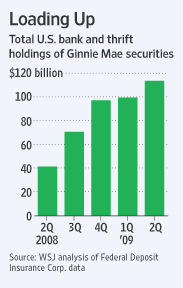Ginnie Mae Accounts For 20% Of New Mortgages In 2009
Another fascinating article from two Thursdays ago in The Wall Street Journal about how Ginnie Mae and the Federal Housing Administration are playing an increasingly large role in the mortgage market (“Banks Load Up on Mortgages, in New Way: This Time, Once-Burned Firms Are Buying U.S. Backed Ginnie Mae Bonds, a Boost For FHA”, The Wall Street Journal, September 10, C1). The Federal Home Administration buys mortgage from banks for low-income borrowers who can’t make a big down payment. Ginnie Mae securitizes those mortgages and guarantees payment on them.
Because regulators allow banks to treat Ginnie Mae mortgage back securities as risk free assets, they are attractive for banks to hold and banks are buying a lot of them (see attached chart). For example, First State Bank of Union City, Tenn. increased its holdings of Ginnie Mae’s to $66 million on June 30, 2009 from $4 million a year ago. The 32-branch bank used a significant amount of the $20 million in TARP funds it received to buy Ginnie Mae’s.

That is allowing the FHA and Ginnie Mae to grow enormously, with Ginnie Mae backing $298 billion in mortgage backed securities through August, more than double last year’s amount and amounting to 20% of all new mortgages in the US through August.
This is fascinating and important because it is just another example of how the government is subsidizing the housing market.
Further, the ultimate costs will be borne by the federal government. These FHA loans guaranteed by Ginnie Mae are starting to go bad, just like Fannie and Freddie loans did last year. That means Ginnie Mae has to dig into its reserves to meet its guarantees. When the gap between interest and principal payments on its mortgage assets and what it has guaranteed grows too large, it will have to receive tax payer money. So again, this supports the housing market but there is no free lunch. Ultimately, there will be a price.
